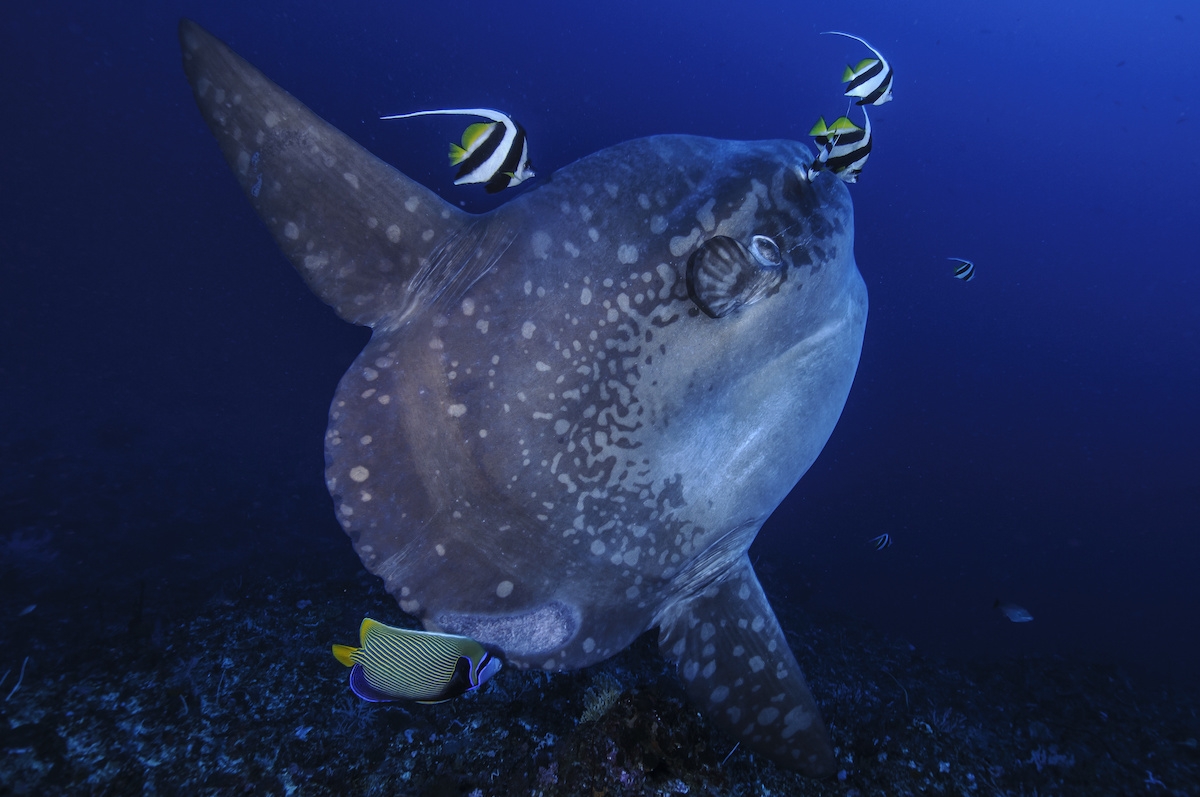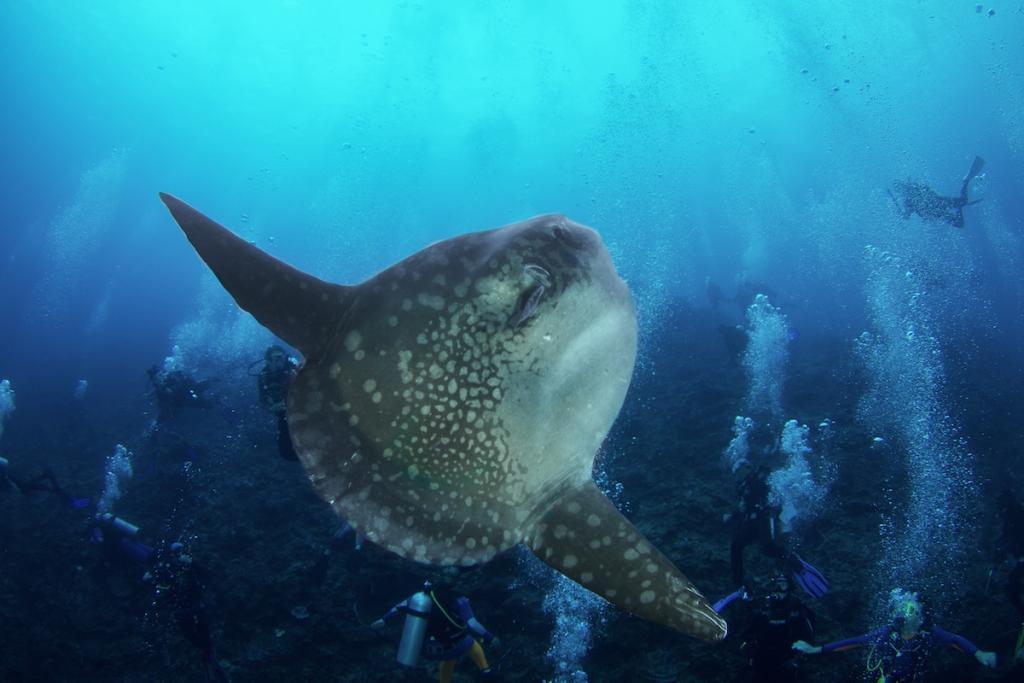
© Everybody want to see such a sunfish underwater.

© An amazing experience to see a sunfish underwater.
Searching for Sunfish ? 3 Top Places to Dive with Mola mola
June 28, 2019
Mola mola or sunfish might be easy to identify, thanks to their unusual looks and habit of lounging at the surface, but these huge fish can only be seen at a few select dive destinations.
Growing up to 3m long and weighing in at over 1000 kg, a Mola mola encounter is certainly an experience not to be missed.
Read on to find out where you can dive with these elusive ocean giants around the world.
The Galapagos Islands
Where can you dive with Mola mola at the Galapagos Islands?
Punta Vicente Roca, one of the Galapagos Islands colder dive sites, is the place to go for sunfish encounters when
Galapagos scuba diving.
These huge fish are commonly seen in the blue, near the wall of this special dive site. As sunfish can be shy, be sure you approach gently and slowly.
Galapagos sunfish are a favourite food of orcas, which hunt in the area. Keep an eye on the blue for their tell-tale black and white markings in the distance.
What else can you see there?
The Galapagos is renowned for its incredible nature encounters both above and below the water. A better question would be what
can’t you see at these enchanting islands.
Not only can you dive with Mola mola, you can also swim among schooling hammerhead sharks, whale sharks, silky and Galapagos sharks.
As well as numerous sharks, you can spot sea turtles at various Galapagos dive sites, graceful eagle rays gliding by, mantas and plenty of schooling fish.
Make sure you dive Cousins Rock to watch marine iguanas feeding underwater and put aside some time to watch Galapagos penguins and sea lions swimming in the shallows.
When is the best time to see Mola mola at the Galapagos Islands?
Mola mola can be seen all year at the Galapagos Islands.
Who is the diving suitable for?
The surge and currents make Galapagos diving best-suited to experienced divers.
That said, some dives are suitable for newer divers and May is a good month for calm conditions and easier diving.
Galapagos liveaboards
The
Nortada is an excellent Galapagos liveaboard choice. This boat caters for a maximum of 12 guests, and so offers more intimate safaris and smaller dive groups.
INDONESIA
Where can you dive with Mola mola in Indonesia?
Bali is home to one of the best places in the world for encounters with Mola mola; Nusa Penida.
Nusa Penida’s Crystal Bay dive site is a renowned cleaning station that attracts Mola mola from the surrounding deep trenches and nutrient-rich waters.
The bay itself is relatively sheltered from currents and water visibility can reach a staggering 45m, making it perfect for sunfish spotting.
What else can you see there?
As well as Mola mola encounters,
Nusa Penida liveaboard diving offers the chance to visit manta ray cleaning stations and around 20 dive sites busy with marine life.
It’s a great place to dive for spotting unusual sharks such as bamboo sharks and wobbegongs, plus nurse and reef sharks.
Wall diving fans won’t want to miss Toyapakeh. This wall dive has strong currents that push nutrients along the wall, supporting an array of species such as giant trevallies, barracuda, moray eels and huge shoals of fish.
Nusa Penida is often visited as part of Komodo liveaboard safaris, giving you the opportunity to dive the best of Komodo’s iconic dive sites.
When is the best time for Mola mola?
July to September is the best time to spot Mola mola, though sightings are possible all year.
Who is the diving suitable for?
The unpredictable currents make some Nusa Penida dive sites best-suited to experienced divers only.
Crystal Bay’s dives are generally more sheltered and accessible to less experienced divers.
Nusa Penida liveaboards
The Emperor Raja Laut is a great choice for a Nusa Penida liveaboard and offers safaris that include the best of Komodo.
OMAN
Where can you dive with Mola mola in Oman?
The northernmost reaches of Oman are a lesser-known Mola mola destination well-worth exploring.
You can spot Mola mola, as well as enjoy pristine dive sites, around the thriving Musandam Peninsula.
What else can you see there?
Whale sharks are the main attraction of the Musandam Peninsula and draw divers in but the reefs themselves are not to be missed.
As a relatively new liveaboard destination, Oman’s reefs are in fantastic condition and free of dive crowds.
There are plenty of corals, nudibranchs, sea turtles, rays and numerous colourful fish swirling around the reefs.
You can also spot dolphins, mantas, whales and large schools of pelagic fish in the blue.
When is the best time for Mola mola?
Oman’s summer months are the best time for spotting Mola mola.
Who is the diving suitable for?
Oman has dives suitable for all experience levels.
Oman liveaboards
The
Oman Aggressor’s Muscat itinerary offers the best chance for Mola mola encounters.
This article was written by divers and writers at LiveAboard.com
Source images: Adobe Stock





